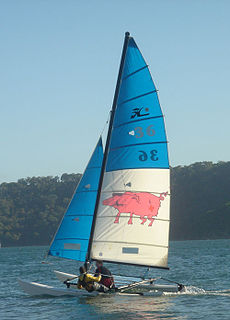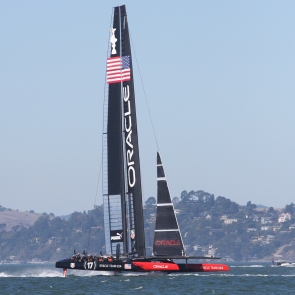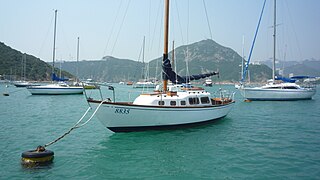Taipan 4.9
The Taipan 4.9 is either constructed professionally from plastic (glass reinforced) or can be home build from plywood. New plastic boats are only available from the manufacturer AHPC, however amateur builders can buy plans to build a plywood boat.

Plywood is a material manufactured from thin layers or "plies" of wood veneer that are glued together with adjacent layers having their wood grain rotated up to 90 degrees to one another. It is an engineered wood from the family of manufactured boards which includes medium-density fibreboard (MDF) and particle board (chipboard).
Designed by Greg Goodall And Jim Boyer in the early 1980s the 4.9 meter Taipan was a development of the Mosquito catamaran, lighter than the Hobie 16, and more similar to the A class in hull design. The sail plan had a higher aspect, and it was lighter overall weight than most North American designs. Rigged and ready to sail the 4.9 weighs a minimum of 231 lb (105 kg). Other features include a wing mast, and later on a spinnaker. Like the Mosquito and Cobra class rules to sail the boat cat rigged (mainsail & more recently with spinnaker for solo sailing) or sloop rigged (Main, Jib & spinnaker for two up sailing). A modified Taipan, with some modifications such as a wider beam and a self-tacking jib, has become one of the foundation boats for the Formula 16 racing class.

The ISAF International Class Hobie 16 (H16) is a popular catamaran manufactured by the Hobie Cat Company for racing and day sailing. The craft was the driving force behind the popularization of beachcats and was recently inducted into the Sailing Hall Of Fame.

A spinnaker is a sail designed specifically for sailing off the wind from a reaching course to a downwind, i.e. with the wind 90–180° off bow. The spinnaker fills with wind and balloons out in front of the boat when it is deployed, called flying. It is constructed of lightweight fabric, usually nylon, and is often brightly coloured. It may be optimised for a particular range of wind angles, as either a reaching or a running spinnaker, by the shaping of the panels and seams.
Specifications
- Length 4.95 m (16 ft 2 in)
- Beam 2.34 m (7 ft 8 in)
- Mast (H) 8.5 m (27 ft 9 in)
- Weight Rigged 105 kg (231 lb)
- Sail Area – Main 14 m² (147 ft2)
- Jib 4.2 m² (45 ft2)
- Spinnaker 17.5 m² (188 ft2)
- Crew 1 (cat rigged) or 2 (Sloop Rigged)
The F16 spec 4.9 has a 2.5 meter beam and a self tacking jib.

Sailing employs the wind—acting on sails, wingsails or kites—to propel a craft on the surface of the water, on ice (iceboat) or on land over a chosen course, which is often part of a larger plan of navigation.

A sloop is a sailing boat with a single mast and a fore-and-aft rig. A sloop has only one head-sail; if a vessel has two or more head-sails, the term cutter is used, and its mast may be set further aft than on a sloop.

A sailboat or sailing boat is a boat propelled partly or entirely by sails smaller than a sailing ship. Distinctions in what constitutes a sailing boat and ship vary by region and maritime culture.

The Lightning is a sloop rigged sailing dinghy originally designed by Olin Stephens of Sparkman & Stephens in 1938 and was first sailed on Skaneateles Lake, NY, United States. More than 15,000 Lightnings have been built since then. There are over 500 fleets of Lightnings worldwide, many of which participate in dinghy racing.

The Hobie Cat is a small sailing catamaran manufactured by the Hobie Cat Company.
Hobie's line of products ranges from surfboards to catamaran sailboats to kayaks and stand-up paddle boards, though the Hobie Cat Company is most famous around the world for its catamarans. Hobie also designed a very successful monohull, the Hobie 33.

The Shields class is a class of keelboat devised in 1963 by US sailor Cornelius Shields, one of the foremost proponents of one-design sailing in the US. He conceived of a modern followup to the International One Design (IOD). The new boat would have the balance and beauty of the IOD while incorporating modern trends such as fiberglass construction. Shields commissioned Olin Stephens of Sparkman and Stephens for the design. The boat was intended for use by the yacht clubs around the Long Island Sound near New York, for racing and training.

The Tasar is a 14-foot (4.3 m) fiberglass 2 person sailing dinghy with a mainsail and jib. Designed by Frank Bethwaite of Sydney in 1975, the boat was technologically advanced for it time and continues to evolved. Aimed at a husband-and-wife or parent-and-child crew hence no spinnaker, it is designed for a combined crew weight of around 140kg. The hull weighs 68kg, and is of sandwich foam construction. The hull has a fine angle at the bow to reduce wave impact drag with unusually clean and sharp chines aft to ensure very free planing and outstanding stability. The foam cored hull is stiff and light and the advanced hull shape, together with an innovative rig which combines a rotating mast with a fully battened main sail, allows the Tasar to plane upwind with the crew normally hiked. The wide beam and a cockpit designed for comfortable hiking make the Tasar easy, fun and very exciting to sail in winds up to 25 knots (46 km/h).

The 18 ft Skiff is considered the fastest class of sailing skiffs. The class has a long history beginning with races on Sydney Harbour, Australia in 1892 and later in New Zealand. The boat has changed significantly since the early days, bringing in new technology as it became available. Because of the need of strength, agility and skill, the class is considered to be the top level of small boat sailing. In Australia this boat is called the "Aussie 18" due to its inherent connections to Australia. It is the fastest conventional non-foiling monohull on the yardstick rating, with a score of 675, coming only third after the Tornado and Inter 20.

A fractional rig on a sailing vessel consists of a foresail, such as a jib or genoa sail, that does not reach all the way to the top of the mast.
A mast aft rig, alternately referred to as aft-mast rig, is a sailboat sail-plan that uses a single mast set in the aft half of the hull. The mast supports fore-sails that may consist of a single jib, multiple staysails, or a crab claw sail. The mainsail is either small or completely absent. Mast aft rigs are uncommon, but are found on a few custom, and production sailboats.

The Melges 32 is a one-design class of sailboat commonly used for racing. The sportsboat is notable for its ability to plane over the water downwind in modest winds, and for its combination of a simple design that is highly tunable.

The 3000 (formally the Laser 3000) is a racing sailing dinghy crewed by two persons with a trapeze for the crew. Launched in 1996 as the Laser 3000, the 3000 was developed from the Laser 2, using the original Frank Bethwaite-designed planing hull combined with a new designed self-draining deck by Derek Clark. Clark also re-designed the rig, using spars and sails from premium proprietary sources and replacing the symmetric spinnaker of the Laser 2 by a larger asymmetric spinnaker (gennaker). The gennaker is chute-launched and retrieved using a single halyard line, and is set on a retractable bowsprit. Helm balance and handling were improved using a shorter-footed mainsail with two full-width battens giving a larger roach. A mast with conventional spreaders replaced the now-unusual diamond arrangement of the Laser 2.
The Stingray Catamaran sport catamaran is an Australian designed 5.5 m long beach catamaran with a twin trapeze setup.

There are three designs of Phantom sailboats, one is a small una rig which is often raced, another is a lateen rig that was designed after the Sunfish model sailing dinghy, and a third is a larger keelboat designed and built in Sydney, Australia.
The Norfolk Heritage Fleet Trust is a waterway society and charitable trust based at Hunter's Yard, Ludham on the Norfolk Broads, England, UK. The Trust maintains and hires out a fleet of wooden sailing yachts from the 1930s.

The Taipan 28 is a cruising sailing yacht. The 28 ft (8.5 m) GRP bermuda rigged sloop was designed and built in Pak Sha Wan, Hong Kong by Interchem Engineers Ltd.
The Viper is a performance catamaran used for racing it is a one design within the Formula 16 class. It is recognised as a class by the International Sailing Federation.
The X1 is a fast, light-weight sailing dinghy designed for sailing on rivers, estuaries and inland waters by Phil Morrison. The dinghy is sailed by 2 or 3 people and has a main, a jib and a symmetric_spinnaker. The boat is designed to be easily driven in very light wind, easy to sail and rig and quick to tack. It has a PY of 949."RYA Portsmouth Yardstick". RYA. Retrieved 2015-03-22.. Currently the PY is the same as an RS400 but can perform better in light wind and slower in heavier winds.
The Marlow-Hunter 50 is an American sailboat that was designed by the Hunter Design Team as a cruiser and first built in 2010.
















